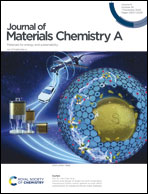Graphene quantum dot engineered ultrathin loose polyamide nanofilms for high-performance nanofiltration†
Abstract
Pursuing high water permeance with ultrahigh selectivity is a longstanding objective for nanofiltration membranes. At present, simultaneously engineering an ultrathin thickness and loose architecture of nanofiltration membranes is in great demand and a severe challenge. Herein, we demonstrate a two-in-one strategy toward ultrathin loose polyamide (ULPA) nanofilms via graphene quantum dot (GQD)-mediated support-free interfacial polymerization. Featuring favorable chemical interactions and size, GQDs serve as quasi-molecule-scale regulators to reduce the diffusion rate of piperazine, and generate ULPA nanofilms with a controllable thickness from 18.3 to 5.5 nm. Concomitantly, GQDs are incorporated into ULPA during interfacial polymerization to construct a loose structure, which is manifested by an enlarged pore size. The resultant ULPA composite membranes overcome the upper-bound limit of polyamide membranes, exhibiting a water permeance of 32.1 L m−2 h−1 bar−1 with an ultrahigh Na2SO4 rejection of 99.6%, as well as an unprecedented Cl−/SO42− selectivity of 205.8 that reaches the highest value ever reported. This two-in-one strategy may open a facile avenue to design advanced membranes for environmental and energy relevant applications.



 Please wait while we load your content...
Please wait while we load your content...